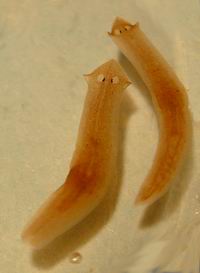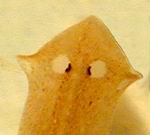|
|
[WORM-LIKE ANIMALS]
|
|
|
|
20a
|
|
Animal worm-like (vermiform) or grub-like; body segmented or annulated (constricted in rings at regular intervals; may require some magnification; Fig. 1b)
|
[21]
|
|
|
20b
|
|
Animal vermiform, but lacking multiple constrictions or repetitive external structures that indicate segmentation down the length of the body
|
[18]
|
|
~~~ |
|
~~~~~~~~~~~~~~~~~~~~~~~~~~~~~
|
|
21a
|
(17) & (20) |
Vermiform with more than 15 segments, all usually of similar diameter
~ Phylum ANNELIDA
|
[35]
|
|
21b
|
|
Animal more grub-like with fewer than 15 total segments. {Shape somewhat fusiform (like a spindle, tapering down at both ends) or at least fatter through the middle. Larvae
~ Phylum ARTHROPODA ~ Class INSECTA ~ Order DIPTERA
|
[134]
|
|
|
~~~~ |
|
~~~~~~~~~~~~~~~~~~~~~~~~~~~~~
|
|
22a
|
(19) |
 A single opening to digestive cavity (pharynx) located behind head on ventral surface; gastrovascular cavity with a single anterior branch and two postero-lateral branches. { Small (5 to 30 mm), flat worm with two eyespots on the head located beneath circular non-pigmented areas and between (usually) two triangular lateral projections (auricles). Freshwater streams and ponds. Planarian flatworm~ Phylum PLATYHELMINTHES ~ Class TURBELLARIA ~ Order TRICLADIDA ~ Family PLANARIIDAE
A single opening to digestive cavity (pharynx) located behind head on ventral surface; gastrovascular cavity with a single anterior branch and two postero-lateral branches. { Small (5 to 30 mm), flat worm with two eyespots on the head located beneath circular non-pigmented areas and between (usually) two triangular lateral projections (auricles). Freshwater streams and ponds. Planarian flatworm~ Phylum PLATYHELMINTHES ~ Class TURBELLARIA ~ Order TRICLADIDA ~ Family PLANARIIDAE
|
[23]
|
|
22b
|
|
Mouth at front of head and anus near back end. {Small (1 to 30 mm), somewhat flattened worm without auricles, and two to four pairs of eyespots. Freshwater streams and ponds
~ Phylum NEMERTEA ~ Prostoma cf. graecense
|
|
|
|
|
|
~~~~~~~~~~~~~~~~~~~~~~~~~~~~~
|
|
Flatworms refer to a group of small invertebrate animals in the Phylum Platyhelminthes. Flatworms are, of course, very flat. These are unsegmented worm-like critters (see Fig. 2, above) with but a single digestive track opening ("mouth") on the underside of the body. In Hawai‘i, numerous species of very colorful flatworms occur in reef environments (see Keoki & Yuko Stender-Marine Life Photography, Sea Slugs of Hawai‘i,or Flatworms of Maui). In freshwater, however, the diversity of flatworms is limited to but a few plain colored types that "glide" across the bottom of pools and are distinguished by somewhat goofy-looking paired eyspots and, in most cases, "ear-like" projections called auricles (Fig. 3).
|
|
23a
|
(22) |
 Auricles (paired ear-like flaps near head end) are well-defined, arising distinct from lateral margin of body. Dorsal surface covered in gray to brown specks. Eyespots two, well-developed.
Auricles (paired ear-like flaps near head end) are well-defined, arising distinct from lateral margin of body. Dorsal surface covered in gray to brown specks. Eyespots two, well-developed.
|
[24]
|
|
23b
|
|
Auricles weakly developed or more-or-less absent, although body is generally widest across eye-spots
|
[25]
|
|
|
|
|
~~~~~~~~~~~~~~~~~~~~~~~~~~~~~
|
|
24a
|
(23) |
Auricles elongated, sharply pointed. Worm up to 30 mm (1.2 in) long. Streams and pools Dugesia cf. dorotocephala (Woodworth)
|
|
|
24b
|
|
~1 mm by 7 mm long. Freshwater pools and streams flatworm "Type II"
|
|
|
|
|
~~~~~~~~~~~~~~~~~~~~~~~~~~~~~
|
|
25a
|
(23) |
Auricles evident as widening of body across well-developed eye-spots. Color transparent except for white internal organs and dorsal surface flecked with white and light tan, dark brown flecks along midline forming a small loop over mouth area. To 2 x 10 mm flatworm "Type I"
|
|
|
25b
|
|
Auricles absent, body hardly at all wider at eyespots than at mid-point. Eyes weakly developed and close to midline. Color transparent with white organs and numerous small white flecks. 0.5 mm by 4 mm flatworm "Type III"
|
|